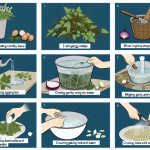The Power of Vertical Gardening
Small gardens can feel limiting, but with the right techniques, you can maximize every inch of space. One of my favorite tricks for tiny gardens is using trellises to grow plants vertically. This not only saves space but also adds a beautiful architectural element to your garden.
Choosing the Right Trellis
It all starts with selecting the appropriate trellis for your garden space and plant needs. Here are some tips to guide you:
- Material: Opt for materials that are durable and fit the aesthetic of your garden. Wood, metal, and bamboo are common choices.
- Size: Ensure the trellis is tall and sturdy enough to support your plants as they grow. A good rule of thumb is to have it at least 5-6 feet high.
- Style: Different plants need different types of support. For instance, peas and beans will climb spiral or grid designs, while tomatoes need a more rigid structure.
Positioning Your Trellis
Placement is key when installing a trellis. Consider the following:
- Sunlight: Most climbing plants require full sun. Position your trellis where it will receive at least 6 hours of direct sunlight each day.
- Wind: Reduce wind damage by placing the trellis near a windbreak, such as a fence or building, or by anchoring it securely into the ground.
- Access: Ensure you can easily reach the trellis for pruning, harvesting, and maintenance.
Best Plants for Trellises
Certain plants naturally thrive when grown vertically. Here are some top choices for small gardens:
- Tomatoes: Indeterminate tomato varieties can grow quite tall and benefit immensely from trellising.
- Cucumbers: These vines easily climb and will produce straighter fruits when grown vertically.
- Peas and Beans: Both bush and pole varieties are excellent for trellises, though pole varieties naturally climb higher.
- Squash and Melons: Small-fruited varieties like acorn squash or smaller melons can be trellised to save ground space.
- Flowering Vines: Consider planting Morning Glory, Clematis, or Sweet Peas for a burst of color and fragrance.
Advanced Tips for Trellis Gardening
To take your trellis gardening to the next level, consider these advanced tips:
- Interplanting: Utilize the space at the base of your trellis for smaller plants like lettuce or radishes. These crops can take advantage of the partial shade created by the climbing plants.
- Pruning: Regularly trim your climbing plants to encourage healthy growth and prevent them from overwhelming your trellis.
- Companion Planting: Pair trellised plants with companions that can deter pests and boost growth. For example, basil and marigold work well with tomatoes.
- Training Plants: Gently guide young vines to the trellis and secure them with soft ties if necessary. This ensures they grow in the desired direction.
Troubleshooting Common Issues
As with any gardening technique, trellis gardening can come with its challenges. Here’s how to address some common issues:
- Weak Trellis: If your trellis isn’t sturdy enough, reinforce it with additional stakes or create a lattice framework for extra support.
- Pest Control: Climbing plants can sometimes attract pests like aphids or spider mites. Regularly inspect your plants and use organic treatments like neem oil or insecticidal soap as needed.
- Plant Overgrowth: If your plants become too bushy, prune them back to ensure adequate airflow and light penetration.
Mastering the art of trellis gardening can turn even the tiniest plot into a lush, productive space. Whether you’re growing edible plants or ornamental vines, these tips will help you make the most of every square foot.



GIPHY App Key not set. Please check settings